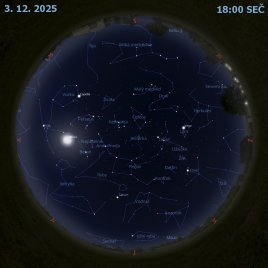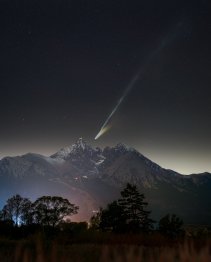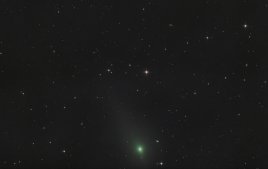 Slunce očima i vodíkem
Slunce očima i vodíkem
Přehled událostí na obloze a v kosmonautice od 1. 12. do 7. 12. 2025. Měsíc bude v úplňku, projde Plejádami a setká se s Jupiterem. Od setmění je nad jihem Saturn. Nízko na ranní obloze je Merkur. Velmi vysoká bude nyní aktivita Slunce. Uvidíme polární záře? Komety večer ruší Měsíc a ráno to brzy nebude lepší. Na Bajkonuru došlo k poškození jediné rampy sloužící pro mise lodí Sojuz a Progress k ISS. ESA na následující roky posílila rozpočet. Před 500 lety se narodil český astronom Tadeáš Hájek z Hájku.

Titul Česká astrofotografie měsíce za říjen 2025 obdržel snímek „Kométa C/2025 A6 Lemmon a Lomnický štít“, jehož autorem je astrofotograf Robert BarsaCitron je žlutý kyselý plod citroníku z druhu citrusovitých. Používá se nejen v potravinářství … A právě jméno tohoto plodu si vybrali naši

3I/ATLAS – medzihviezdna kométa na návšteve Medzihviezdna kométa 3I/ATLAS patrí medzi veľmi vzácnu skupinu objektov, o ktorých vieme, že do našej Slnečnej sústavy prileteli z iného hviezdneho systému. Pohybuje sa po silno hyperbolickej dráhe, takže ju pri ďalšom obehu už znovu neuvidíme – len raz preletí okolo Slnka a opäť zmizne do medzihviezdneho priestoru. Na zábere z ranných hodín 28. 11. 2025 dominuje zelenkastá kóma kométy v spodnej časti obrazu. Jemný prachový chvost sa rozlieva šikmo nahor medzi hviezdami, ktoré ostávajú ostré a nehybné – pekná pripomienka toho, že sledujeme rýchleho hosťa na pozadí vzdialeného hviezdneho poľa našej Galaxie. Aj keď 3I/ATLAS na oblohe nepatrí k najjasnejším kométam, možnosť zachytiť medzihviezdnu návštevníčku je výnimočná. Každý takýto objekt prináša jedinečný pohľad na materiál a históriu iných planetárnych systémov – a táto fotografia je malou “pamiatkou” na jej krátku zastávku v našej kozmickej „štvrti“. Už z voľby kompozície je jasné že som čakal trocha výraznejší chvost ???? Technické údaje: Vybavenie: SkyWatcher NEQ6Pro, GSO Newton 200/800 (200/600 F3) + Starizona Nexus 0.75×, Touptek ATR585M mono, AFW-M + Touptek LRGB filtre, Gemini EAF, guiding TS Off-axis + PlayerOne Ceres-C, SVBony 241 power hub, automatizovaná astrobúdka s mojím vlastným OCS (Observatory Control System). Software: NINA, Astro Pixel Processor, PixInsight, Adobe Photoshop. Expozície: L 20x60s, RGB 12×90 s, master bias, flats, darks, darkflats. Gain 150, Offset 300. 28.11.2025 Belá nad Cirochou, severovýchod Slovenska, bortle 4